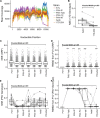Analysis By Deep Sequencing of Discontinued Neurotropic Yellow Fever Vaccine Strains
- PMID: 30194325
- PMCID: PMC6128858
- DOI: 10.1038/s41598-018-31085-2
Analysis By Deep Sequencing of Discontinued Neurotropic Yellow Fever Vaccine Strains
Abstract
Deep sequencing of live-attenuated viral vaccines has focused on vaccines in current use. Here we report characterization of a discontinued live yellow fever (YF) vaccine associated with severe adverse events. The French neurotropic vaccine (FNV) strain of YF virus was derived empirically in 1930 by 260 passages of wild-type French viscerotropic virus (FVV) in mouse brain. The vaccine was administered extensively in French-speaking Africa until discontinuation in 1982, due to high rates of post-vaccination encephalitis in children. Using rare archive strains of FNV, viral RNAs were sequenced and analyzed by massively parallel, in silico methods. Diversity and specific population structures were compared in reference to the wild-type parental strain FVV, and between the vaccine strains themselves. Lower abundance of polymorphism content was observed for FNV strains relative to FVV. Although the vaccines were of lower diversity than FVV, heterogeneity between the vaccines was observed. Reversion to wild-type identity was variably observed in the FNV strains. Specific population structures were recovered from vaccines with neurotropic properties; loss of neurotropism in mice was associated with abundance of wild-type RNA populations. The analysis provides novel sequence evidence that FNV is genetically unstable, and that adaptation of FNV contributed to the neurotropic adverse phenotype.
Conflict of interest statement
The authors declare no competing interests.
Figures



References
-
- Monath, T. P., Gershman, M., Staples, J. E. & Barrett, A. D. T. Yellow Fever Vaccine, in Vaccines, Plotkin, S., Orenstein, W., Offit, P., editors, Philadelphia, PA: Elsevier Inc., sixth edition (2013).
-
- Lloyd W, Penna HA. Studies on the pathogenesis of neurotropic yellow fever virus in Macacus rhesus. The American Journal of Tropical Medicine and Hygiene. 1933;13:1–45. doi: 10.4269/ajtmh.1933.s1-13.1. - DOI
Publication types
MeSH terms
Substances
Grants and funding
LinkOut - more resources
Full Text Sources
Other Literature Sources
Molecular Biology Databases

